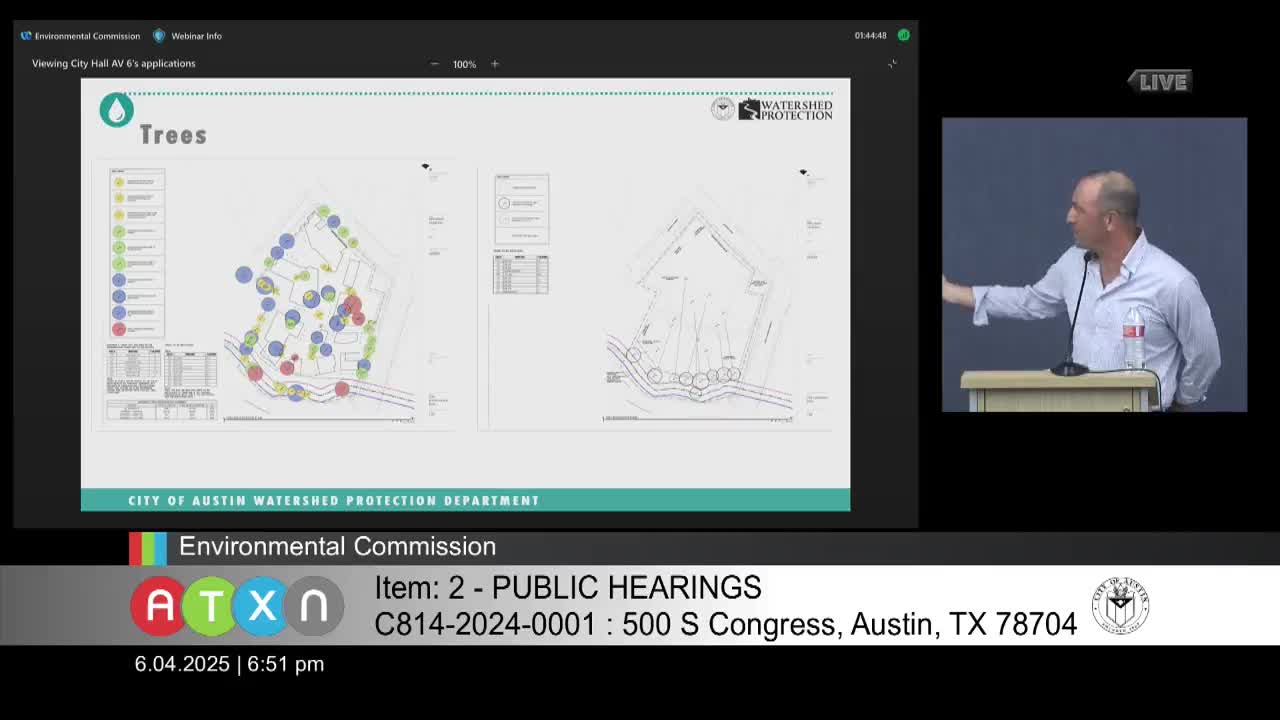City Arborist recommends tree relocation for South Congress and Riverside streetscape project
June 04, 2025 | Austin, Travis County, Texas
This article was created by AI summarizing key points discussed. AI makes mistakes, so for full details and context, please refer to the video of the full meeting. Please report any errors so we can fix them. Report an error »

On June 4, 2025, the Austin Environmental Commission convened to discuss critical developments regarding urban landscaping and environmental regulations in the city. The meeting highlighted the ongoing efforts to integrate sustainable practices into city planning, particularly concerning street trees and underground parking structures.
A significant topic of discussion was the requirement for street trees as part of site development permits. The commission noted that while the design for the streetscape is still in progress, there are plans to plant new trees along South Congress and Riverside, adhering to city standards that mandate a minimum caliper size of five inches. This initiative aims to enhance urban greenery and improve the overall aesthetic and environmental quality of the area.
However, challenges arose regarding the relocation of existing heritage and protected trees. City officials expressed concerns about placing large trees within the right-of-way, which led to a recommendation from the city arborist to move these trees to a nearby creek instead. This decision reflects a broader commitment to preserving Austin's natural resources while balancing urban development needs.
Another key point of discussion was the implications of an underground parking garage on impervious cover calculations. The city recommended that the garage be counted as impervious cover, which is significant for flood management and environmental compliance. The discussion clarified that the design would include a minimum of four feet of soil above the garage, which is intended to mitigate flood risks by allowing water to infiltrate the soil rather than run off into the surrounding area.
The commission also addressed the carbon impact statement required by city code. This statement is essential for assessing the environmental effects of new developments. Ecological consultants reported that the planned riparian restoration efforts could sequester approximately five tons of carbon annually, contributing positively to the city's climate goals. The methodology for calculating carbon sequestration relies on established models, such as the I Tree system, which evaluates the impact of newly planted trees.
In conclusion, the discussions at the Austin Environmental Commission meeting underscored the city's ongoing commitment to sustainable urban development. The integration of green infrastructure, such as street trees and responsible management of impervious surfaces, reflects a proactive approach to environmental stewardship. As these projects move forward, they will play a crucial role in shaping Austin's ecological landscape and addressing the challenges posed by urbanization.
A significant topic of discussion was the requirement for street trees as part of site development permits. The commission noted that while the design for the streetscape is still in progress, there are plans to plant new trees along South Congress and Riverside, adhering to city standards that mandate a minimum caliper size of five inches. This initiative aims to enhance urban greenery and improve the overall aesthetic and environmental quality of the area.
However, challenges arose regarding the relocation of existing heritage and protected trees. City officials expressed concerns about placing large trees within the right-of-way, which led to a recommendation from the city arborist to move these trees to a nearby creek instead. This decision reflects a broader commitment to preserving Austin's natural resources while balancing urban development needs.
Another key point of discussion was the implications of an underground parking garage on impervious cover calculations. The city recommended that the garage be counted as impervious cover, which is significant for flood management and environmental compliance. The discussion clarified that the design would include a minimum of four feet of soil above the garage, which is intended to mitigate flood risks by allowing water to infiltrate the soil rather than run off into the surrounding area.
The commission also addressed the carbon impact statement required by city code. This statement is essential for assessing the environmental effects of new developments. Ecological consultants reported that the planned riparian restoration efforts could sequester approximately five tons of carbon annually, contributing positively to the city's climate goals. The methodology for calculating carbon sequestration relies on established models, such as the I Tree system, which evaluates the impact of newly planted trees.
In conclusion, the discussions at the Austin Environmental Commission meeting underscored the city's ongoing commitment to sustainable urban development. The integration of green infrastructure, such as street trees and responsible management of impervious surfaces, reflects a proactive approach to environmental stewardship. As these projects move forward, they will play a crucial role in shaping Austin's ecological landscape and addressing the challenges posed by urbanization.
View full meeting
This article is based on a recent meeting—watch the full video and explore the complete transcript for deeper insights into the discussion.
View full meeting
